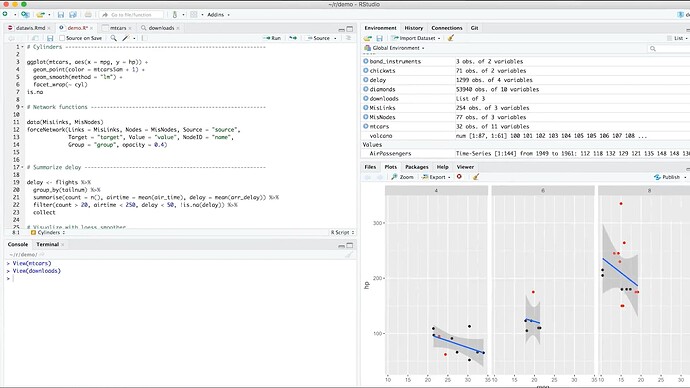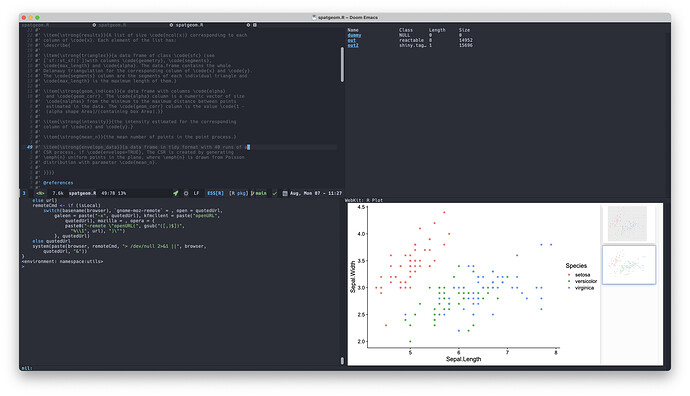Hi guys!
I use R for my work, and I used RStudio Server, but for internal policies the access was closed. Trying ESS in doom the experience was a little rough. I installed spacemacs with the ESS layer and it was much smoother.
This post is to start a discussion about a refactor for the ESS module to improve the experience for the final user.
Note: I have all the motivation, but not all the lisp skills, to do this massive task. Of course, I offer my help with the refactor and co-maintain the module.
Note 2: I have started a branch in my doom’s fork to start playing around with the configuration. Please feel free to contribute as much as you want.
Initial ideas
The layout
The R editor de facto is RStudio, so I think that a good start could be to take this layout as the starting point.
I’m not attached to this, of course, but I think that this could be less intimidating to beginners that want to try Emacs as your R editor.
In my config.el I have this naive configuration for it. It needs a lot of work, though.
(set-popup-rule! “^\\*R.*\\*” :side ‘bottom :width 0.5 :quit nil :ttl nil)
(set-popup-rule! “^\\*R Data View.*\\*” :side ‘top :slot 1 :width 0.5 :quit nil :ttl 0)
(set-popup-rule! “^\\*R dired\\*” :side ‘right :slot -1 :width 0.33 :quit nil :ttl 0)
(set-popup-rule! “^\\*help\\[R\\]” :side ‘right :slot 1 :width 0.33 :quit nil :ttl 0))
The Buffers’ behavior
This is tricky because Emacs allows the user to have total freedom here.
In the current state of the module, if you open the *R* process and press ESC or q, it kills the buffer and, of course, the process (all the loaded data is lost).
The options here help with this problem
(set-popup-rule! “^\\*R.*\\*” :side ‘bottom :width 0.5 :quit nil :ttl nil)
Also, I have those for the same problem.
(map! :after ess-help
:map ess-help-mode-map
:n “q” nil
:n “ESC” nil)
(map! :after ess-rdired
:map ess-rdired-mode-map
:n “q” nil
:n “ESC” nil)
Another idea is to use something like zoom for putting emphasis on the code, the *R* process, the environmental variables, etc.
Performance
I’m lost here, but it would be great to see if there are some configurations to do for lsp-mode and eglot.
Also, there is no configuration by default for lsp-mode over TRAMP. It’s just to put this in some place:
(lsp-register-client
(make-lsp-client
:new-connection
(lsp-stdio-connection '("R" "--slave" "-e" "languageserver::run()"))
:major-modes '(ess-r-mode inferior-ess-r-mode)
:remote? t
:server-id 'lsp-R-remote))
Speaking of TRAMP, I don’t know what kind of improvements we could do to reduce the latency when the user interacts with the *R* process.
More ideas
-
Better integration with
polymode/poly-Rto edit Markdown files. Also see if it’s possible to integrate it with aas y lass. -
Quarto integration through quarto-emacs.
-
Embedded plot into a buffer. I don’t know if it is possible, but here there are some old ideas. We can explore if there is something better.
Final
This is will be my first big project for doom. All the feedback and help is very welcome.
Thanks.

